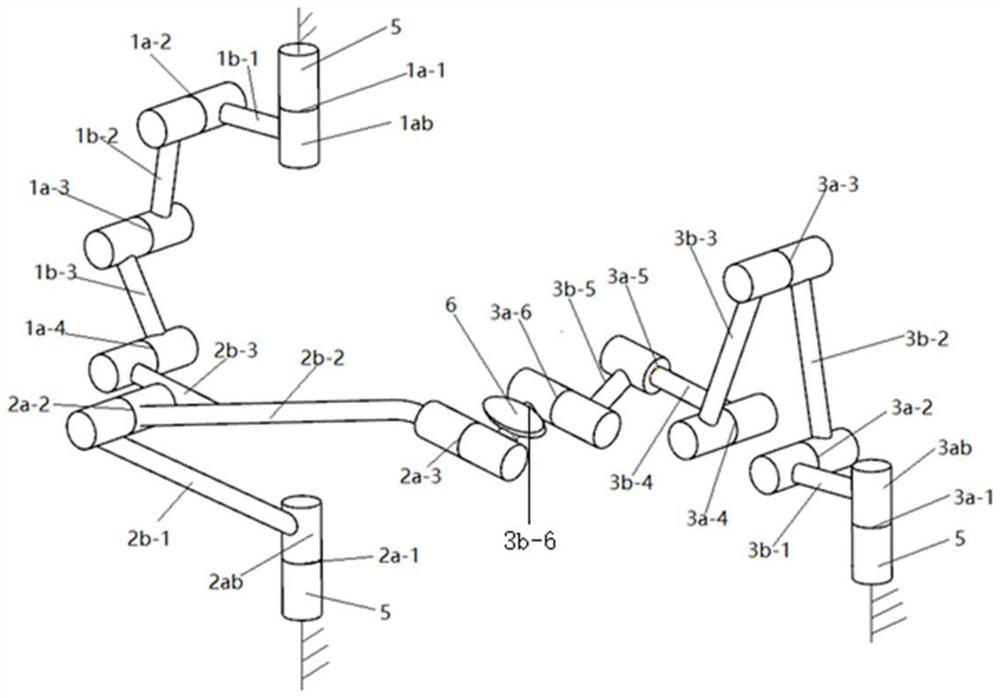A Three-Rotation-DOF Space Decoupling Mechanism for Virtual-Axis Machine Tools and Robots
A robot and three-rotation technology, applied in manipulators, program-controlled manipulators, manufacturing tools, etc., can solve problems such as difficult control, incomplete decoupling, and complex structures
- Summary
- Abstract
- Description
- Claims
- Application Information
AI Technical Summary
Problems solved by technology
Method used
Image
Examples
Embodiment 1
[0028] A three-rotation-degree-of-freedom space decoupling mechanism for virtual-axis machine tools and robots, the structure of which is as follows figure 1 As shown, it includes a static platform 5, a dynamic platform 6, and a first kinematic branch chain II 1ab, a second kinematic branch chain II 2ab, and a third kinematic branch chain III 3ab connected between the static platform 5 and the dynamic platform 6.
[0029] The first motion branch chain I 1ab is mainly composed of the first rotation pair I 1a-1, the second rotation pair I 1a-2, the third rotation pair I1a-3, the fourth rotation pair I 1a-4, and the first connecting rod I 1b -1. The second connecting rod I 1b-2 and the third connecting rod I 1b-3 are composed, and the driving pair is the second rotating pair I 1a-2. The second kinematic branch chain II 2ab is mainly composed of the first rotating pair II 2a-1, the second rotating pair II 2a-2, the third rotating pair II 2a-3, the first connecting rod II 2b-1, the...
Embodiment 2
[0035] The specific application of the three-rotational degrees of freedom space decoupling mechanism for virtual axis machine tools and robots: the three drive pairs are driven separately, and each drive only controls one rotational degree of freedom of the braking platform, which can realize the complete decoupling of the three rotational degrees of freedom . The first connecting rod I 1b-1 and the first connecting rod II 2b-1 are connected to the static platform 5 through the first rotating pair I 1a-1 and the first rotating pair II2a-1 respectively, and the first rotating pair I 1a-1 There are four rotating pairs whose axes are parallel to each other between the first rotating pair II 2a-1, which are the second rotating pair I 1a-2, the third rotating pair I 1a-3, the fourth rotating pair I 1a-4 and The second rotary pair II 2a-2, and the axes of the first rotary pair I 1a-1 and the second rotary pair II 2a-2 are collinear and perpendicular to the axes of the four parallel...
PUM
 Login to View More
Login to View More Abstract
Description
Claims
Application Information
 Login to View More
Login to View More - Generate Ideas
- Intellectual Property
- Life Sciences
- Materials
- Tech Scout
- Unparalleled Data Quality
- Higher Quality Content
- 60% Fewer Hallucinations
Browse by: Latest US Patents, China's latest patents, Technical Efficacy Thesaurus, Application Domain, Technology Topic, Popular Technical Reports.
© 2025 PatSnap. All rights reserved.Legal|Privacy policy|Modern Slavery Act Transparency Statement|Sitemap|About US| Contact US: help@patsnap.com

